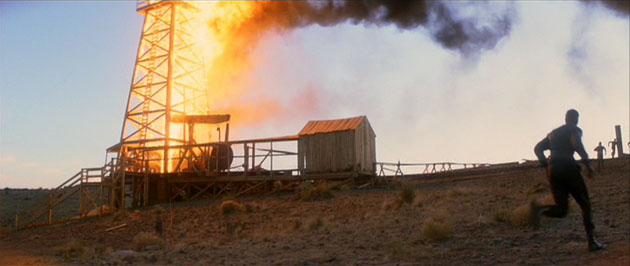Jack Fisk

The boy’s bedroom, which we created in our main house, didn’t work in the morning. There was no window light at that time. So we had another house three blocks down the street that was similar but faced east and we recreated the bedroom there. We changed the woodwork to match the original. So we had the kid’s bedroom here and the kid’s bedroom there. But we didn’t have the budget to duplicate some of the dressing so if Terry decided he wanted to shoot the boy’s room in the morning the dressers and anyone that was kind enough to help would be moving it quickly over to the other location.
That’s the way it was with a lot of Terry’s scenes. Everything was around the light. Most of scenes were shot near windows. I put a translucent roof on the porch to let more light in, but if it was too dark to shoot inside we’d just move outside and shoot that scene or another scene that Terry would think up.
AS: That movie looked beautiful.
JF: I loved working with Chivo. He’s such a pleasant person. He taught me that a “light-sandwich” was when you have light coming from two different sources, and it’s not as flattering as one strong source. So we would black out other windows and just concentrate on the one the sun was coming through.
When we’re not using lights I can look at the set and know what it’s gonna look like on film. I’ve had sets destroyed by over-lighting. Or false lighting. It drives me crazy. Then you get DPs that are great – our work sings.
AS: Chivo’s amazing.
JF: With Chivo I go out with my camera and shoot stills and I can show him, This is what this window looks like at two in the afternoon, and we are able to discuss the possibilities of a location. I also worked very well with the cinematographer on There Will Be Blood, Robert Elswit. I don’t envy the daily pressure on the cinematographer.
AS: What is your style when leading your crew?
JF: We are a team. For crews my first requirement is that they can do whatever they do better than I can do what they do. And hopefully, better than anybody else. And the second is that they’re as pleasant as possible. You know I work with David Crank a lot and he’s just so happy. He’s just a happy person. And Ruth De Jong, my assistant art director, is always enthusiastic. Any time you give them a challenge it’s like, Let’s do it! And that’s really important in our work. It’s a stress-filled job that, if you know you’re in it together somehow you’re going to make it work. Failure is not an option. And that’s why I look for people who are positive and passionate in a crew.
Pingback: K.K. Barrett
Pingback: Laurence Bennett
Pingback: Adam Stockhausen
Pingback: Colin Gibson